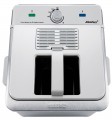cooking t
The cooking temperature provided by the device. Most models are adjustable, so this item indicates the operating temperature range.
Deep frying is carried out at temperatures from 130 to
190 °С200 °С. But
high operating temperatures (over 200°) are less common.
Basket capacity
The capacity of the deep fryer basket or multi-oven bowl, or air fryer flask (see "Type") in kilograms is the maximum amount of food that can be loaded into the device at one time.
For deep fryers used in everyday life, a capacity of up to 0.6 – 0.8 kg is considered quite sufficient; it is rarely useful to fry numerous foods at a time at home. But models that can hold from a kilogram or more are designed mainly for industrial use — in cafes, canteens, etc. In turn, multi-ovens with a capacity of up to 0.8 kg can be called small, up to 1.5 kg — medium, more than 1.5 kg — large. Air fryers have approximately the same capacity.
Volume
The volume of the multi-cooker bowl, deep fryer basket, air fryer container, or the cooking chamber of a multi-oven.
This parameter is measured in liters and is directly related to the capacity of the basket (see above) — larger volumes are required for a greater quantity of food. For deep fryers (see "Type"), this parameter is usually specified not by the total volume but by the amount of oil needed for standard operation, providing an estimate of how much oil is required for the appliance. In models with separate compartments (see below), the volume may be indicated for each section individually.
Separate container
Models in which the capacity is divided or can be divided into several separate compartments — most often two.
The main purpose of this function is to enable the simultaneous cooking of two different types of food in the appliance without mixing them. In multi-ovens, the separation of the cooking space is typically achieved through a removable partition that can be installed or removed as needed. In deep fryers with this feature, the working capacity is initially divided into two compartments, and the device comes with
two baskets. This design allows for the option of cooking with a half load by using only one compartment and one basket.
Deep fryers with
a separate container are most often large in size and capacity, but this rule does not apply to multi-ovens.
Power consumption
The power consumed by the device during operation. Usually indicated by the maximum energy consumption, at the most intensive mode of operation.
Large capacity requires more power. However, devices with similar characteristics may differ in this parameter. It is worth noting that, other things being equal, lower power does not mean more economical energy consumption: cooking in such a device takes more time and as a result, the amount of energy spent is almost the same. At the same time, lower power means less load on the electrical grid, which can be important in houses with poor wiring.
Material
The main material from which the body of the device is made.
—
Plastic. Plastic offers several key advantages including its affordability, ease of processing and wide range of colors. These factors contribute to the cost-effectiveness and appealing appearance of kitchen appliances. While plastic may not be as durable as metal, it is still reliable enough for regular household use. Consequently, many appliances designed for home use are made of plastic. However, it's important to note that plastic cases are sensitive to overheating and can melt at relatively low temperatures. Over time, they may also develop scratches.
—
Metal. Metal is highly durable and reliable, making it suitable for powerful professional appliances that are frequently used, such as deep fryers in cafes and restaurants. It can withstand high temperatures without issue. However, metal cases are more expensive to manufacture compared to plastic cases due to the complexity of the production process. Metal also has high thermal conductivity, which can affect heat distribution. As a result, in household devices, it is common to find a combination of metal and plastic in their construction. In some cases, only the central part of the case is made of metal, while the remaining parts are made of plastic. This helps to balance durability, cost, and thermal conductivity.

